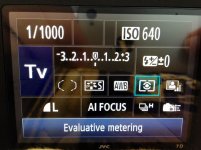kuzeycem
Medicinal Birding

Hello
I just bought a Canon EOS 7D + 400mm f/5.6 yesterday. I did some trial shots today, they were generally rather nice but there were some photos which were slightly worse than I expected.
So what are the right settings for birding on 7D? It is pretty much sunny here, so ISO's not a very big problem. But still some of my pictures get a little too bright or dark, and sometimes even blurry.
I am pretty sure it's me rather than the camera but I still wanted to ask about this. Of course there is no "right setting" for anything but I would like to hear your opinions and advice!
Thank you.
I just bought a Canon EOS 7D + 400mm f/5.6 yesterday. I did some trial shots today, they were generally rather nice but there were some photos which were slightly worse than I expected.
So what are the right settings for birding on 7D? It is pretty much sunny here, so ISO's not a very big problem. But still some of my pictures get a little too bright or dark, and sometimes even blurry.
I am pretty sure it's me rather than the camera but I still wanted to ask about this. Of course there is no "right setting" for anything but I would like to hear your opinions and advice!
Thank you.




